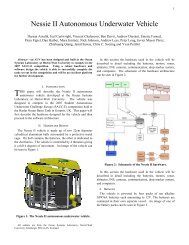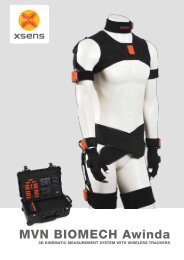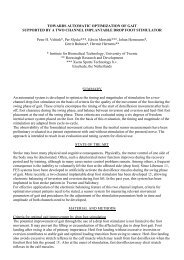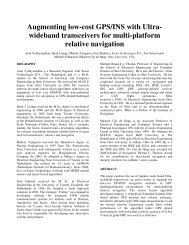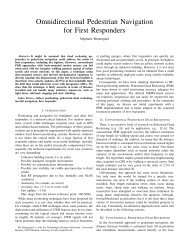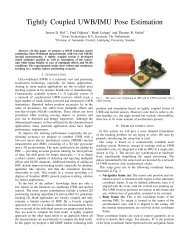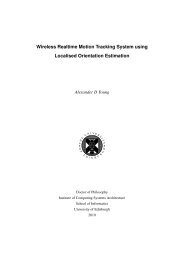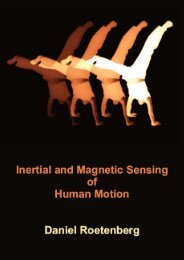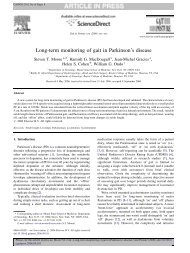Drift-Free Dynamic Height Sensor using MEMS IMU Aided ... - Xsens
Drift-Free Dynamic Height Sensor using MEMS IMU Aided ... - Xsens
Drift-Free Dynamic Height Sensor using MEMS IMU Aided ... - Xsens
Create successful ePaper yourself
Turn your PDF publications into a flip-book with our unique Google optimized e-Paper software.
<strong>Drift</strong>-<strong>Free</strong> <strong>Dynamic</strong> <strong>Height</strong> <strong>Sensor</strong> <strong>using</strong><br />
<strong>MEMS</strong> <strong>IMU</strong> <strong>Aided</strong> by <strong>MEMS</strong> Pressure <strong>Sensor</strong><br />
Makoto Tanigawa, Henk Luinge, Linda Schipper, and Per Slycke (<strong>Xsens</strong> Technologies)<br />
Abstract— We demonstrate a low-cost, low-power, and small<br />
form factor solution to drift-free high-resolution vertical<br />
positioning by f<strong>using</strong> <strong>MEMS</strong> accelerometers with <strong>MEMS</strong><br />
barometric altimeter. In this system, the highly responsive but<br />
drift-prone aspect of the <strong>MEMS</strong> accelerometers is stabilized by<br />
barometric altimeter and high-fidelity height tracking is achieved.<br />
Typical vertical human movements such as walking up or down a<br />
staircase can be tracked in real-time with this system. The height<br />
tracking performance is benchmarked against a reference system<br />
<strong>using</strong> a tactical-grade <strong>IMU</strong> and an error analysis is performed.<br />
I. INTRODUCTION<br />
Barometric altimeters along with radar altimeters have been<br />
used to aid Inertial Navigation Systems (INS) in order to<br />
stabilize the vertical position estimates for applications in<br />
aviation [3,4]. For human motion characterization, barometric<br />
altimeters have been used in classifying the vertical movement<br />
patterns into moving up, down, or remaining level [1,2].<br />
Recently, a pedestrian navigation system integrating GPS,<br />
<strong>MEMS</strong> <strong>IMU</strong> (Inertial Measurement Unit), barometric<br />
altimeter, and transponder demonstrated stable indoor/outdoor<br />
pedestrian position tracking, in which a barometric altimeter<br />
and transponders were used to stabilize dead-reckoning of<br />
<strong>IMU</strong> indoors [6]. In this paper, we demonstrate drift-free highresolution<br />
vertical positioning <strong>using</strong> <strong>MEMS</strong> <strong>IMU</strong> fused with<br />
complementary <strong>MEMS</strong> barometric altimeter for<br />
indoor/outdoor applications under dynamics typical for human<br />
movements. Using a low-cost <strong>MEMS</strong> Attitude and Heading<br />
Reference System (AHRS) with integrated GPS and<br />
barometric altimeter, we show how a barometric altimeter can<br />
be used to stabilize the drift-prone double-integration of<br />
accelerometer signals in real-time, while retaining the highly<br />
dynamic and responsive characteristic of the accelerometers<br />
which is useful in identifying different movements. In this<br />
article we focus on tracking relative changes in height, and not<br />
the absolute height, in order to isolate the error sources.<br />
Absolute height calibration can be performed <strong>using</strong> GPS or<br />
other methods [6]. The barometric altimeter is sensitive to<br />
fluctuations in atmospheric pressure which often results in<br />
undesired height drift. We use a reference barometric altimeter<br />
as a possible solution to mitigate the weather effects.<br />
The performance of height tracking is compared against a<br />
reference system consisting of a tactical-grade <strong>IMU</strong>. This<br />
system enables measurement of accuracy on sample-by-sample<br />
basis and helps to optimize the Kalman filter that fuses the<br />
individual sensor signals. Since the reference system also<br />
measures the orientation error, the effect of orientation error<br />
on the height estimation is also analyzed.<br />
II. METHODS<br />
A. System Description Overview<br />
We use an <strong>Xsens</strong> MTi-G sensor, which is a miniature <strong>MEMS</strong><br />
Attitude and Heading Reference System (AHRS) containing<br />
3D gyroscopes, 3D accelerometers, 3D magnetometers, a GPS<br />
receiver and a barometric altimeter. Since we are mainly<br />
interested in demonstrating the fusion of accelerometer and the<br />
barometric altimeter, we ignore the GPS data and only<br />
consider the orientation, accelerometer, and barometer data.<br />
The approach will be to compute the change in height by<br />
double-integrating accelerometer signal and stabilizing it with<br />
the relative height measurement obtained from a barometric<br />
altimeter <strong>using</strong> a Kalman filter. We show that this combination<br />
gives stable high-resolution height measurements under<br />
dynamic conditions typical of human movements. Although it<br />
is possible to use the absolute altitude information from the<br />
GPS receiver to calibrate the relative barometric height<br />
measurements, we confine ourselves to tracking relative<br />
changes in height.<br />
B. Integration of acceleration<br />
The accelerometer signal (yacc) contains the acceleration minus<br />
the gravity vector in the sensor frame. The vertical<br />
acceleration is computed by considering the accelerometer<br />
signal in the direction of the vertical and adding the<br />
acceleration due to gravity;<br />
s s<br />
a = zi y + g = z y cosθ<br />
+ g<br />
(1)<br />
acc acc<br />
where s z is the direction of the vertical vector in the sensor<br />
reference frame obtained from the AHRS directly. The<br />
parameter g is the local value of the acceleration due to<br />
gravity, and θ is the angle between yacc and<br />
1<br />
s z. The<br />
acceleration vector in the sensor frame, however, contains bias<br />
and gain errors due to temperature calibration errors, bias<br />
instability, and etc. The effect of those errors on the net<br />
vertical acceleration in the global frame can be visualized in<br />
Fig. 1. Note that the situation depicted is at rest, thus no net<br />
acceleration is present.
ε<br />
g0<br />
S z<br />
θ<br />
α<br />
y acc<br />
b<br />
Kg0<br />
Figure 1: The effect of accelerometer bias and gain error<br />
on the net vertical acceleration.<br />
Here the temperature calibrated accelerometer signal is<br />
modeled as;<br />
y acc = Kg0 + b + n (2)<br />
where g0 is the true gravity vector that would be measured in<br />
the sensor frame if there were no calibration errors, K is the<br />
gain error also expressed as K = (I+∆), with I the identity<br />
matrix and ∆ a diagonal matrix, b is the accelerometer bias<br />
vector expressed in the sensor frame, and n is additive white<br />
Gaussian noise. The apparent net vertical acceleration, ε,<br />
including gain and bias errors, is then (ignoring the effect of<br />
noise);<br />
s<br />
y acci z g ( Kg0 s<br />
b) i z g<br />
( I ∆) g0 s<br />
z b<br />
s<br />
z ( g0 δ g )<br />
( )<br />
ε = − = + −<br />
= + i + i − +<br />
(3)<br />
= g cosθ − 1 + ∆g cosθ + bcos α −δ<br />
g<br />
0 0<br />
where g = g0 + δg is the locally assumed value of acceleration<br />
due to gravity. Note that ∆ = |∆| and g0 = |g0|. The true<br />
magnitude of acceleration due to gravity is g0 while the error<br />
in the assumed value is δg. The first term in (3) is the effect of<br />
orientation error, the second term is due to the combination of<br />
gain error and orientation error, the third term is the effect of<br />
bias, and the last term is the error in assumed value of local<br />
acceleration due to gravity. Ignoring the gain error term and<br />
<strong>using</strong> an approximation cosθ ≈ 1-θ 2 /2 leads to;<br />
g θ<br />
= − + bcos − g<br />
(4)<br />
2<br />
2<br />
ε 0 α δ<br />
For typical human movements, the acceleration due to gravity<br />
is the dominant component in the accelerometer signal,<br />
ca<strong>using</strong> s z and yacc to be roughly parallel in Fig. 1. Because of<br />
this, the small-angle approximation for the cosine function<br />
dictates that small errors in inclination have only a moderate<br />
effect on the computed vertical acceleration than the horizontal<br />
acceleration. In the presence of large horizontal acceleration,<br />
however, even a small orientation error would give a sizable<br />
error in the vertical acceleration. Heading errors have no<br />
adverse effect for height estimation.<br />
The projection of accelerometer bias vector on the vertical,<br />
however, is directly proportional to the magnitude of the bias<br />
vector. An accelerometer with bias instability of 1 mg can still<br />
yield ½ (0.01m/s 2 )(100s) 2 = 50 m of large height drift only<br />
after 100 seconds. Likewise, the under- or over-estimation in<br />
the local value of acceleration due to gravity, δg, also has a<br />
direct effect on the net acceleration estimation. We shall see<br />
that those components dominate the error in height estimation<br />
when the accelerometer noise is not an important factor. In the<br />
absence of orientation error, accelerometer gain error, and<br />
accelerometer bias, the height error would be purely due to the<br />
random walk process of the accelerometer noise. In this case,<br />
the standard deviation of the height error is a second-order<br />
random walk process whose standard deviation is<br />
characterized by σ(t) = σt 3/2 sqrt(T/3), where σ is the noise<br />
density of the accelerometer, t is the time, and T is the sample<br />
period.<br />
Thus the accelerometer bias and local value of acceleration<br />
due to gravity are important parameters which need to be<br />
accurately estimated in order to obtain reasonable<br />
performance. In a tightly-coupled system of <strong>IMU</strong> and<br />
barometric altimeter, those parameters can be estimated as a<br />
Kalman state, but since we are limiting ourselves here to a<br />
loosely-coupled system we treat the accelerometer bias and the<br />
local value of acceleration due to gravity as constants which<br />
need to be estimated beforehand. The accelerometer bias and<br />
acceleration due to gravity can be estimated from measuring<br />
several static orientations and assuming the model in (2).<br />
C. Relative Barometric <strong>Height</strong> Measurement<br />
When the pressure sensor is used as altimeter that measures<br />
change in height, the pressure as measured in Pascal is<br />
converted to change in height in meters by [5];<br />
0. 19 ⎛ ⎞<br />
⎛ P ⎞<br />
∆h<br />
= 44330 ⋅⎜1 − ⎜ ⎟ ⎟ − h<br />
⎜ P ⎟<br />
⎝ ⎝ 0 ⎠ ⎠<br />
where hinit is calculated at Pinit and P0 is the standard pressure<br />
defined as 101.325 kPa. The height measurement contains<br />
thermal noise and a significant amount of quantization noise<br />
due to a relatively coarse resolution of about 0.2 m. These give<br />
the overall noise standard deviation of about 1 m at an update<br />
rate of 7 Hz. In order to obtain an accuracy of 0.1 m <strong>using</strong> the<br />
barometric altimeter alone, several seconds of averaging<br />
init<br />
(5)<br />
2
would be necessary. Therefore, relatively high noise level and<br />
low update rate make it unsuitable for tracking highly dynamic<br />
movements, but it is still useful for stabilizing the drift-prone<br />
accelerometers.<br />
D. Barometric <strong>Height</strong> Correction <strong>using</strong> Reference<br />
Barometer<br />
During unstable weather the atmospheric pressure fluctuations<br />
can easily result in a few meters per hour of drift in terms of<br />
height. The altitude obtained from GPS or updates from other<br />
sources like transponders can be used to correct for these<br />
effects [6], but here we consider the possibility to deploy a<br />
reference barometric altimeter which is left stationary to<br />
monitor any local fluctuations in altitude due to fluctuations in<br />
atmospheric pressure. With a reference barometer, the relative<br />
change in height can be accurately tracked reliably for longer<br />
periods.<br />
E. F<strong>using</strong> Information <strong>using</strong> Two-state Kalman Filter<br />
In order to fuse both measurements <strong>using</strong> a Kalman filter, the<br />
above equations have to be related in a state-space format. The<br />
two Kalman states are chosen to be the height and the velocity.<br />
In state-space, the integration of vertical acceleration to<br />
position is expressed as;<br />
1 2<br />
⎡ht ⎤ ⎡1 T ⎤ ⎡ht −1<br />
⎤ ⎡ a ⎤ 2 tT<br />
⎢ ⎥ = ⎢ + ⎢ ⎥<br />
v 0 1<br />
⎥ ⎢ ⎥<br />
⎣ ⎦ v Ta<br />
⎣ t ⎦ ⎣ t −1<br />
⎦ ⎣ t ⎦<br />
where h is the height, v is the vertical speed, T is the sampling<br />
period of the accelerometer, and a is the vertical net<br />
acceleration in the global frame. The sample period was<br />
chosen to be 0.005s (200 Hz). Note that it is important to<br />
estimate the bias on the accelerometer signal and compensate<br />
for it. The altimeter signal, hbaro, is modeled as zero-mean<br />
additive white Gaussian noise process with a standard<br />
deviation of 1 m.<br />
(6)<br />
hbaro = ht + w t , w ~ N(0,1 m )<br />
(7)<br />
The accelerometer signal is also modeled as zero-mean<br />
additive white Gaussian noise with standard deviation of 0.008<br />
m/s 2 .<br />
F. Experimental Procedure<br />
Two experiments were designed to test and analyze the<br />
performance of height tracking, with the first experiment<br />
foc<strong>using</strong> on error analysis and the second experiment foc<strong>using</strong><br />
on application to indoor height tracking of humans.<br />
Experiment 1 (high-resolution error analysis)<br />
An <strong>Xsens</strong> MTi-G sensor was fixed to a tactical-grade <strong>IMU</strong><br />
which is used as a reference height measurement (Fig. 2), and<br />
the calculated heights were compared. The reference <strong>IMU</strong> is<br />
equipped with a 3-axis fiber-optic gyroscope (FOG) with 3axis<br />
servo accelerometers, which achieves an orientation drift<br />
(measured in terms of angle random walk standard deviation)<br />
of 0.1 deg./hr. The reference height is calculated by double-<br />
integration of the vertical acceleration given by the reference<br />
<strong>IMU</strong>. Since this method also allows the orientation error of the<br />
MTi-G to be tracked, the influence of orientation error on the<br />
height estimation can be analyzed. A second barometric<br />
altimeter is left stationary to be used as reference barometer.<br />
Figure 2: <strong>Xsens</strong> MTi-G AHRS sensor mounted on tactical-grade <strong>IMU</strong> for<br />
high-resolution height error analysis. Second MTi-G sensor is used as a<br />
reference barometric altimeter.<br />
Experiment 2 (stability analysis under human movements)<br />
To test the height stability and accuracy under typical human<br />
motion (walking) in an indoor office environment, an <strong>Xsens</strong><br />
MTi-G was strapped to the chest (Fig. 3) and walked up and<br />
down a staircase with a landing halfway up the stairs. The<br />
height difference was known (3.42 m). A second sensor, again,<br />
is used to monitor any drift in height as result of atmospheric<br />
pressure variation during the experiment.<br />
Figure 3: <strong>Xsens</strong> MTi-G AHRS <strong>Sensor</strong> strapped to the chest for height<br />
tracking during walking up and down a staircase.<br />
III. EXPERIMENTAL RESULTS<br />
A. Experiment 1 (high-resolution error analysis)<br />
The <strong>IMU</strong> signals (accelerometer and gyroscope magnitudes)<br />
during the experiment are shown in Fig. 4, clearly<br />
distinguishing the periods of motion and no motion. After 20<br />
seconds of rest at the table height (1.10 m above the floor), the<br />
sensor was lifted off the table and moved up and down rapidly<br />
for about 8 seconds with vertical displacement of<br />
3
approximately +/- 0.50 m and returned to the original position<br />
and orientation for 10 seconds. The sensor was then lifted<br />
from the table again and brought down nearly to the floor and<br />
hoisted up to about 2 meters and then brought back to the<br />
original position and orientation.<br />
Acceleration<br />
(m/s 2 )<br />
Angular Velocity<br />
(deg/s)<br />
20<br />
10<br />
0<br />
0 30 60<br />
100<br />
50<br />
0<br />
0 30 60<br />
Time (s)<br />
© <strong>Xsens</strong> Technologies B.V., 19-Feb-2008.<br />
Figure 4: Acceleration and angular velocity magnitude signal during<br />
Experiment 1.<br />
The sensor orientation during the movement, in terms of Euler<br />
angles (roll, pitch, and yaw), is shown in Fig. 5. The maximum<br />
inclination experienced during the experiment was about 10<br />
degrees.<br />
Roll<br />
(deg)<br />
Pitch<br />
(deg)<br />
Yaw<br />
(deg)<br />
5<br />
0<br />
-5<br />
0<br />
20<br />
30 60<br />
0<br />
-20<br />
0<br />
10<br />
30 60<br />
0<br />
-10<br />
0 30 60<br />
Time (s)<br />
© <strong>Xsens</strong> Technologies B.V., 19-Feb-2008.<br />
Figure 5: Euler angles (orientation) of the sensor during Experiment 1.<br />
Shown are roll (above), pitch (middle), and yaw (below).<br />
Figure 6: Velocity (above) and height (below) comparison. For the height<br />
plot, the reference height from a tactical-grade <strong>IMU</strong> (thin line) and MTi-<br />
G (thick line) are compared. The height obtained from the MTi-G is<br />
stabilized by the barometric-altimeter and the barometer drift due to<br />
change in atmospheric pressure is compensated <strong>using</strong> the reference<br />
barometer. The barometric altimeter samples are shown in dots.<br />
The vertical velocity and position results are shown in Fig. 6.<br />
In the height plot (below) the heights obtained <strong>using</strong> the<br />
reference <strong>IMU</strong> and the MTi-G are compared. The height error<br />
remained within about +/- 0.2 m throughout the experiment<br />
(also see Fig. 7). Note that the barometric altimeter signal used<br />
to stabilize the height for the MTi-G has been corrected for<br />
height drift due to change in atmospheric pressure.<br />
Furthermore, for both the reference <strong>IMU</strong> and MTi-G, the<br />
accelerometer bias has been estimated from a bias estimation<br />
procedure performed just before the experiment. This<br />
procedure estimates the accelerometer bias from multiple static<br />
orientation measurements. The estimated bias was subtracted<br />
from the accelerometer signal for height estimation.<br />
Inclination error<br />
(deg)<br />
<strong>Height</strong> error<br />
(m)<br />
1<br />
0<br />
-1<br />
0 30 60<br />
0.1<br />
0<br />
-0.2<br />
0 30 60<br />
Time (s)<br />
4<br />
© <strong>Xsens</strong> Technologies B.V., 19-Feb-2008.<br />
Figure 7: Inclination error (above) and height error (below). For each<br />
plot, the reference inclination/height is obtained from a tactical-grade<br />
<strong>IMU</strong>. The gray line in the height error plot (below) shows the height<br />
error when the inclination error is eliminated.<br />
Figure 7 shows the inclination error and height error during the<br />
movement. The reference orientation and height were obtained<br />
from the reference <strong>IMU</strong> whose orientation has been<br />
compensated for the rotation rate of the Earth. The inclination<br />
error during the experiment remained less than one degree,<br />
which is about the expected accuracy of <strong>MEMS</strong>-based lowcost<br />
AHRS under the given conditions.<br />
The corresponding height error plot in Fig. 7 suggests very<br />
little correlation between the inclination error and height error.<br />
In fact, when the orientation error is eliminated from the MTi-<br />
G (by <strong>using</strong> the orientation from reference <strong>IMU</strong>), the<br />
difference in height output shows very little change (shown by<br />
the gray line Fig. 7). This follows from the theoretical<br />
expression (4) in which the error in the vertical acceleration is<br />
quadratic in inclination error (inclination error is usually much<br />
smaller than unity). This result implies that the error in height<br />
is almost entirely due to the residual accelerometer bias for<br />
this experiment.<br />
In this experiment, we have tried to isolate the error<br />
contribution from barometer drift by making use of a reference
arometric altimeter which remained stationary during the<br />
experiment. Figure 8 shows the height calculated with and<br />
without the reference barometer. The benefits of <strong>using</strong> a<br />
reference barometer can clearly be seen in this figure. The<br />
measured rate of pressure change during the experiment was<br />
approximately +190 Pascal/hr (or -16 m/hr in height), which<br />
corresponds to the transition between stable good weather and<br />
unstable high pressure system [5].<br />
<strong>Height</strong> (m)<br />
1<br />
0.5<br />
0<br />
-0.5<br />
-1<br />
0 30 60<br />
Time (s)<br />
© <strong>Xsens</strong> Technologies B.V., 19-Feb-2008.<br />
Figure 8: <strong>Height</strong> with barometer drift compensation <strong>using</strong> a reference<br />
barometer (solid) and without correction (grey). The reference height<br />
from a tactical-grade <strong>IMU</strong> is also shown by the dashed line.<br />
B. Experiment 2: Stability under walking motion<br />
In this experiment, the MTi-G sensor was strapped to the chest<br />
as shown in Fig. 3 and a staircase with a landing was walked<br />
up and down. Figure 9 shows the accelerometer and gyroscope<br />
magnitudes during the experiment. The starting position is<br />
marked by the first 7 seconds of no motion. The second floor<br />
was reached around 30 seconds after and five squats were<br />
performed between 35 and 42 seconds. The rest of the<br />
measurement was walking down the same flight of stairs and<br />
coming to rest at the initial position.<br />
Acceleration<br />
(m/s 2 )<br />
Angular Velocity<br />
(deg/s)<br />
30<br />
20<br />
10<br />
0<br />
0 30 60<br />
300<br />
200<br />
100<br />
0<br />
0 30 60<br />
Time (s)<br />
© <strong>Xsens</strong> Technologies B.V., 19-Feb-2008.<br />
Figure 9: Accelerometer and gyroscope magnitude data captured during<br />
walking up and down a staircase.<br />
The corresponding vertical velocity and height after fusion of<br />
accelerometer and barometric altimeter are shown Fig. 10, in<br />
which the actual height difference of 3.42 m has been marked<br />
by the dotted lines. Note that the footsteps are clearly visible in<br />
the velocity plot. Steps taken while actually walking up and<br />
down the stairs can be distinguished from steps taken while<br />
remaining level in the velocity plot. Note also that the<br />
calculated height has been compensated for the measured<br />
pressure drift rate of -93 Pa/hr (characterized by stable rainy<br />
weather [5]). This rate corresponds to +7.7 m/hr.<br />
Accelerometer bias measurements were performed before and<br />
after the experiment, in which six static orientations were<br />
measured.<br />
A good stability of height estimation can be seen by comparing<br />
the height just before and after the squat. At those times, the<br />
height difference with respect to the initial height is nearly<br />
equal the actual height difference between the first and second<br />
floor.<br />
Figure 10: <strong>Height</strong> estimation stabilized by barometric altimeter when<br />
walking up and down a flight of stairs (with squatting five times on the<br />
second floor). Reference barometer is used to correct for barometric<br />
drift.<br />
IV. CONCLUSION<br />
We have demonstrated drift-free high-resolution vertical<br />
positioning by f<strong>using</strong> <strong>MEMS</strong> accelerometers with<br />
complementary <strong>MEMS</strong> barometric altimeter. This low-cost,<br />
low-power, and small form factor system enables highresolution<br />
vertical positioning in real-time under dynamics<br />
typical of human movements. In the first experiment, a<br />
tactical-grade <strong>IMU</strong> was used to measure height errors and<br />
showed that the height error was bounded by +/- 0.2 m after<br />
correcting for the drift in barometric altimeter reading due to<br />
fluctuations in atmospheric pressure. It was also confirmed<br />
that the orientation error has a rather minor effect on the height<br />
accuracy as long as the orientation error is not too large and<br />
that the movements do not contain significant horizontal<br />
acceleration. Under those conditions the accelerometer bias<br />
was identified to be the most critical factor in obtaining good<br />
vertical accuracy. The second experiment, in which the<br />
integrated sensor was strapped to the chest, showed good<br />
accuracy and stability while walking up and down a staircase.<br />
This system can be easily augmented by GPS or other means<br />
such as transponders to enable absolute height measurement. It<br />
was demonstrated that the use of reference barometric<br />
5
altimeter, if available, can be a viable option in eliminating the<br />
height drift due to change in the atmospheric pressure.<br />
V. DISCUSSION<br />
In this paper, we deliberately decoupled the orientation<br />
estimation and height estimation for facilitating the error<br />
analysis, but they could be integrated into a tightly-coupled<br />
system in which the accelerometer bias can be estimated as an<br />
additional Kalman state. Since the bias of <strong>MEMS</strong><br />
accelerometers do change with time due to inherent bias<br />
instability, temperature, and other effects, it would be highly<br />
desirable to estimate it as a Kalman state.<br />
In the error analysis, the inclination error played a minor role<br />
in contributing to the height error compared to the gain and<br />
bias errors. The amount of inclination error, however, highly<br />
depends on the type of movement the sensors experience, and<br />
it may lead to significant orientation error during certain kind<br />
of movements. In that case, the orientation error would, of<br />
course, be an important factor in the height error.<br />
VI. ACKNOWLEDGEMENTS<br />
This publication has been supported by EC-contract FP6-IST-<br />
34120, Action line 2.5.2 Micro based subsystems. The support<br />
is greatly acknowledged. This publication reflects only the<br />
authors’ views. The European Community is not liable for any<br />
use that may be made of the information contained therein.<br />
REFERENCES<br />
[1] Sagawa, K.; Ishihara, T.; Ina, A.; Inooka, H, Classification of human<br />
moving patterns <strong>using</strong> air pressure and acceleration., Industrial<br />
Electronics Society, 1998. IECON '98. Proceedings of the 24th Annual<br />
Conference of the IEEE Volume 2, 31 Aug.-4 Sept. 1998 Page(s):1214 -<br />
1219 vol.2<br />
[2] Sagawa, K.; Inooka, H.; Satoh, Y, Non-restricted measurement of<br />
walking distance.; Systems, Man, and Cybernetics, 2000 IEEE<br />
International Conference on, Volume 3, 8-11 Oct. 2000 Page(s):1847 -<br />
1852 vol.3<br />
[3] Gray, R.A.; Maybeck, P.S., An integrated GPS/INS/baro and radar<br />
altimeter system for aircraft precision approach landings; Aerospace<br />
and Electronics Conference, 1995. NAECON 1995., Proceedings of the<br />
IEEE 1995 National Volume 1, 22-26 May 1995 Page(s):161 - 168<br />
vol.1<br />
[4] R, G. Brown and P . Y. C. Hwang, Introduction to Random Signals and<br />
Applied Kalman Filtering, 3 rd Edition, Wiley & Sons, 1997, ISBN 0-<br />
471-12839-2<br />
[5] VTI Technologies Application Note: SCP1000-D01(E)/D11(E) Pressure<br />
<strong>Sensor</strong><br />
[6] Weimann, F, Abwerzger, G, and Hofmann-Wellenhof, B. A Pedestrian<br />
Navigation System for Urban and Indoor Environments, Proceedings<br />
ION GNSS 2007.<br />
6




